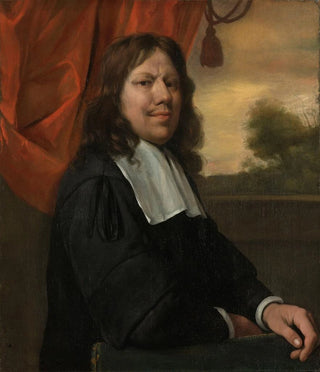Art print | Self-portrait - Jan Steen


View from behind

Frame (optional)
Jan Steen's Self-Portrait is an iconic artwork that immerses the viewer in the vibrant world of 17th-century Dutch painting. Through this painting, the artist does not merely depict himself; he also offers an intimate and personal vision of his universe. The light, color, and meticulous details combine to create a lively and engaging atmosphere. This piece serves as a true mirror of the soul, revealing the passions and concerns of an artist deeply rooted in his era. The art print of Self-Portrait - Jan Steen allows for rediscovering this masterpiece while immersing oneself in the richness of its history and context.
Style and uniqueness of the work
Jan Steen's Self-Portrait stands out for its dynamic composition and skillful use of color. The artist, known for his ability to capture everyday life, manages here to blend realism and expressiveness. The features of his face, both vivid and detailed, testify to sincere introspection. The choice of colors, ranging from warm tones to darker shades, creates a play of light that emphasizes the depth of the piece. The surrounding elements, such as everyday objects, add a narrative dimension that invites prolonged contemplation. This work is not limited to a simple self-portrait; it is an open window into the creative mind of a man who knew how to immortalize his time through a unique and inimitable style.
The artist and his influence
Jan Steen, a major figure of the Dutch Golden Age, left his mark on his era with his ability to capture life in all its forms. Born in 1626, he quickly established himself as one of the most prolific painters of his time. His work, rich in detail and emotion, reflects a society in full transformation, where daily life and customs are depicted with a gaze that is both critical and amused. Steen drew inspiration from his contemporaries while developing a style that was his own, blending humor and social observation. His influence endures through the centuries, inspiring many artists and continuing to question viewers about the nature of art and representation. The Self-Portrait, at this

Matte finish

View from behind

Frame (optional)
Jan Steen's Self-Portrait is an iconic artwork that immerses the viewer in the vibrant world of 17th-century Dutch painting. Through this painting, the artist does not merely depict himself; he also offers an intimate and personal vision of his universe. The light, color, and meticulous details combine to create a lively and engaging atmosphere. This piece serves as a true mirror of the soul, revealing the passions and concerns of an artist deeply rooted in his era. The art print of Self-Portrait - Jan Steen allows for rediscovering this masterpiece while immersing oneself in the richness of its history and context.
Style and uniqueness of the work
Jan Steen's Self-Portrait stands out for its dynamic composition and skillful use of color. The artist, known for his ability to capture everyday life, manages here to blend realism and expressiveness. The features of his face, both vivid and detailed, testify to sincere introspection. The choice of colors, ranging from warm tones to darker shades, creates a play of light that emphasizes the depth of the piece. The surrounding elements, such as everyday objects, add a narrative dimension that invites prolonged contemplation. This work is not limited to a simple self-portrait; it is an open window into the creative mind of a man who knew how to immortalize his time through a unique and inimitable style.
The artist and his influence
Jan Steen, a major figure of the Dutch Golden Age, left his mark on his era with his ability to capture life in all its forms. Born in 1626, he quickly established himself as one of the most prolific painters of his time. His work, rich in detail and emotion, reflects a society in full transformation, where daily life and customs are depicted with a gaze that is both critical and amused. Steen drew inspiration from his contemporaries while developing a style that was his own, blending humor and social observation. His influence endures through the centuries, inspiring many artists and continuing to question viewers about the nature of art and representation. The Self-Portrait, at this






